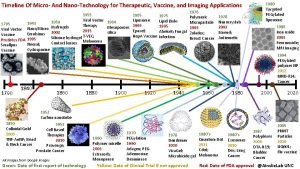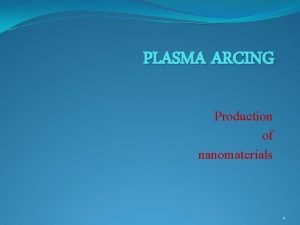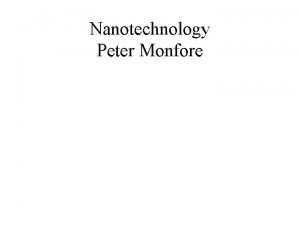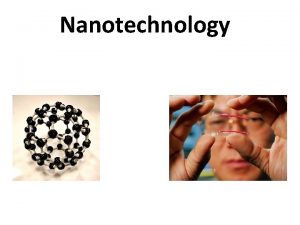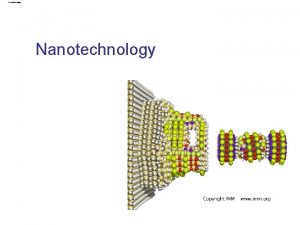Nanotechnology 25102016 1 Nanoscince and Nanotechnology The word













- Slides: 13

Nanotechnology 25/10/2016 1

Nanoscince and Nanotechnology The word ‘nano’ is a Greek prefix meaning dwarf or something very small and depicts one billionth (10 -9) of a unit. Nanomaterials, therefore, refer to the class of materials with at least one of the dimensions in the nanometric range. 1 25/10/2016

In the case of polycrystalline materials, the grain size is typically of the order of 1– 100 microns (1 micron = 10 -6 m). Nanocrystalline materials have a grain size of the order of 1− 100 nm, and are therefore 100– 1000 times smaller than conventional grain dimensions, so, they can no longer be treated as infinite systems and the resultant boundary effects lead to fascinating and useful properties, which can be explored and tailored for a variety of structural and functional applications. 25/10/2016 3

nanomaterials may be classified as those materials which have at least one of their dimensions in the nanometric range, below which there is significant variation in the property of interest compared to microcrystalline materials. Nanomaterials can be metals, ceramics, polymers or composites. Nanotechnology is an umbrella term for many areas of research dealing with objects that have one of their dimensions in the realm of a few hundreds of nanometres. The term ‘nanotechnology’ was first coined by Norio Taniguchi in 1974. Table (1) refer to the small scales. 25/10/2016 4

Table (1): - The world of small dimensions Number Name Symbol 0. 1 deci d 0. 01 centi c 0. 001 milli m 0. 000 001 micro μ 0. 000 001 nano n 0. 000 000 001 pico p 0. 000 000 001 femto f 0. 000 000 000 001 atto a 0. 000 000 000 001 zepto z 0. 000 000 001 yocto y 25/10/2016 5

Important terms: Nanomaterial: class of materials in which at least one of the dimensions is on the nanoscale (<100 nm) Nanotechnology: study of manipulating matter on an atomic and molecular scale; generally deals with structures sized between 1 and 100 nanometres in at least one dimension, and involves developing materials or devices possessing at least one dimension within that size. 25/10/2016 6

Nanosize and Properties When particle sizes of solid matter in the visible scale are compared to what can be seen in a regular optical microscope, there is little difference in the properties of the particles. But when particles are created with dimensions of about 1– 100 nanometers (where the particles can be “seen” only with powerful specialized microscopes), the materials’ properties change significantly from those at larger scales. This is the size scale where so-called quantum effects rule the behavior and properties of particles. Properties of materials are size-dependent in this scale range. Thus, when particle size is made to be nanoscale, properties such as melting point, fluorescence, electrical conductivity, magnetic permeability, and chemical reactivity change as a function of the size of 25/10/2016 the particle. 7

Nanoscale gold illustrates the unique properties that occur at the nanoscale. Nanoscale gold particles are not the yellow colour with which we are familiar; nanoscale gold can appear red or purple. At the nanoscale, the motion of the gold’s electrons is confined. Because this movement is restricted, gold nanoparticles react differently with light compared to larger-scale gold particles. In fact, gold can be used as a prime example: a colloid of gold nanoparticles is no longer ‘golden’ but ruby-red in colour as in figure (1). 25/10/2016 8

Figure (1): - The effect of nanosized particles on the colour of gold. 25/10/2016 9

Nanoscale materials have far larger surface areas than similar masses of larger-scale materials. As surface area per mass of a material increases, a greater amount of the material can come into contact with surrounding materials, thus affecting reactivity. If a bulk material is subdivided into an ensemble of individual nanomaterials, the total volume remains the same, but the collective surface area is greatly increased. This is shown schematically in figure (2). 25/10/2016 10

Figure 2: Schematic drawing showing how surface to volume increases as size is decreased. 25/10/2016 11

The consequence is that the surface-to-volume ratio of the material — compared to that of the parent bulk material — is increased. How would the total surface area increase if a cube of 1 m 3 were progressively cut into smaller and smaller cubes, until it is composed of 1 nm 3 cubes? Table (2) summarizes the results. Table (2). 25/10/2016 12

Table (2). 25/10/2016 13
 Advantages and disadvantages of nanotechnology
Advantages and disadvantages of nanotechnology Difference between nanoscience and nanotechnology
Difference between nanoscience and nanotechnology Journal of nanoscience and nanotechnology sci
Journal of nanoscience and nanotechnology sci Timeline of nanotechnology
Timeline of nanotechnology What is nanotechnology
What is nanotechnology Nanotechnology for kids
Nanotechnology for kids Nanotechnology introduction
Nanotechnology introduction Nanotechnology fact or myth
Nanotechnology fact or myth Disadvantages of nanotechnology
Disadvantages of nanotechnology Nanotechnology
Nanotechnology Nanotechnology definition
Nanotechnology definition Conclusion of nanotechnology
Conclusion of nanotechnology Today nanotechnology produced computer transistors
Today nanotechnology produced computer transistors Plasma arcing method
Plasma arcing method



